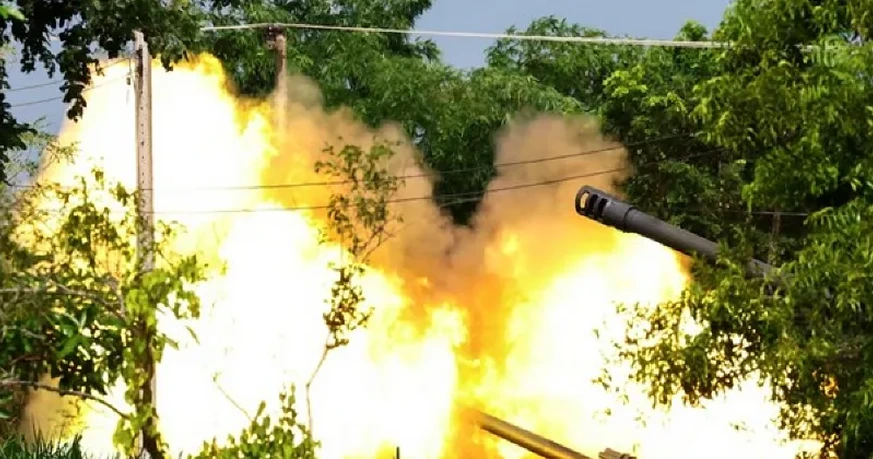Thailand–Cambodia Border Clash 2025: Indian Embassy Issues Travel Advisory as Conflict Escalates
Updated: July 26, 2025 | Location: Phnom Penh, New Delhi | By: Stronic Media Desk
The ongoing Thailand–Cambodia border conflict, which erupted on July 24, 2025, has taken a deadly turn, leaving at least 32 people dead and displacing over 130,000 civilians across both nations. This marks the most intense military confrontation between the two Southeast Asian countries in over a decade.
What Happened at the Border?
The violent clashes broke out near the long-disputed Ta Muen Thom and Ta Krabei temples—located along a 500-mile stretch of contested territory. Both nations have exchanged heavy artillery, rocket fire (BM‑21), and airstrikes, resulting in destruction and chaos in several villages and border outposts.
According to officials, 13 Cambodians have died so far, while Thailand has reported 6 soldiers and 13 civilians killed, including children. More than 130,000 residents from both sides—58,000 Thais and 23,000 Cambodians—have fled their homes and sought temporary shelter in schools, temples, and government facilities.
Indian Embassy Advisory for Nationals in Cambodia

As the border violence continues to escalate, the Indian Embassy in Phnom Penh has issued a strong advisory urging Indian citizens to avoid traveling to any Cambodian-Thai border areas until further notice.
In case of emergency, Indian nationals can contact:
- 📞 Phone: +855 92881676
- 📧 Email: cons.phnompenh@mea.gov.in
Additionally, a separate alert has been issued for India-based travelers, advising them to steer clear of seven Thai provinces bordering Cambodia, which are now under military watch.
Background: Why Are Thailand and Cambodia Fighting?
Although the current skirmish started in July 2025, the tension has been simmering for months. In May 2025, a Thai soldier was severely injured by a landmine in the Nam Yuen district of Thailand’s Ubon Ratchathani province. Thailand accused Cambodia of planting Russian-made PMN-2 anti-personnel mines, in violation of international treaties.
The political backdrop is also heating things up. Reports of leaked phone calls involving Thailand’s Shinawatra family and Cambodia’s Hun Sen and Hun Manet have fueled nationalist outrage and worsened diplomatic relations.
Adding to this, long-standing disputes over temple territories—including the Preah Vihear Temple—remain unresolved, despite a 1962 International Court of Justice (ICJ) ruling.
Military Escalation: Airstrikes, Rockets, and Accusations
On July 24, Cambodian forces allegedly opened fire near Ta Muen Thom. Thailand immediately launched “Operation Yuttha Bodin,” deploying F-16 fighter jets, heavy artillery, and counter-attacks.
Cambodia has accused Thailand of using cluster bombs—banned under the Convention on Cluster Munitions. Thailand denied the claims, citing that it is not a signatory to the treaty.
Meanwhile, both sides have accused each other of:
- Attacking civilian areas
- Targeting hospitals and temples
- Using civilians as human shields
Civilians Displaced: Thousands on the Move
Thousands have abandoned their homes, fearing airstrikes and shelling. Over 5,000 refugees have taken shelter at Thailand’s Chang International Circuit, while others are scattered across schools, temples, race circuits, and public buildings.
“I panicked… then the bomb hit,” said a resident from Ubon Ratchathani, recalling the moment of impact.
Diplomatic Efforts: UN and ASEAN Step In
The United Nations Security Council (UNSC) held a closed-door emergency meeting on July 25, where all 15 member nations urged both sides to exercise restraint and seek peaceful resolution.
Malaysia, chair of ASEAN, offered to mediate the conflict. Cambodia agreed to a ceasefire, while Thailand showed initial interest but later retracted, favoring bilateral discussions over multilateral intervention.
Global Reactions:
- 🇲🇾 Malaysia, 🇮🇩 Indonesia, and 🇲🇲 Myanmar have urged immediate peace talks.
- 🇨🇳 China expressed concern and called for calm.
- 🇺🇸 United States, 🇫🇷 France, and 🇨🇦 Canada have all called for an immediate ceasefire and the protection of civilians.
What Lies Ahead?
▪️ Risk of Full-Scale War
With martial law declared and military movement increasing, analysts warn that this border conflict could spiral into a larger regional war.
▪️ Humanitarian Crisis
Displacement, destroyed infrastructure, and civilian trauma could become unmanageable if peace is delayed.
▪️ Diplomatic Deadlock
Thailand’s preference for bilateral talks may hinder broader international mediation efforts.
▪️ Nationalist Politics
Leaders on both sides are under pressure from nationalist forces, which could complicate efforts to de-escalate.
Conclusion: A Call for Caution
The Thailand–Cambodia border clash of 2025 has already resulted in tragic loss and displacement. With active military zones, escalating rhetoric, and stalled diplomacy, the international community remains on high alert.
For Indian nationals, it is strongly advised to avoid all border zones and keep in touch with the Indian Embassy in Phnom Penh for real-time updates and assistance.
Stay informed, stay safe.

